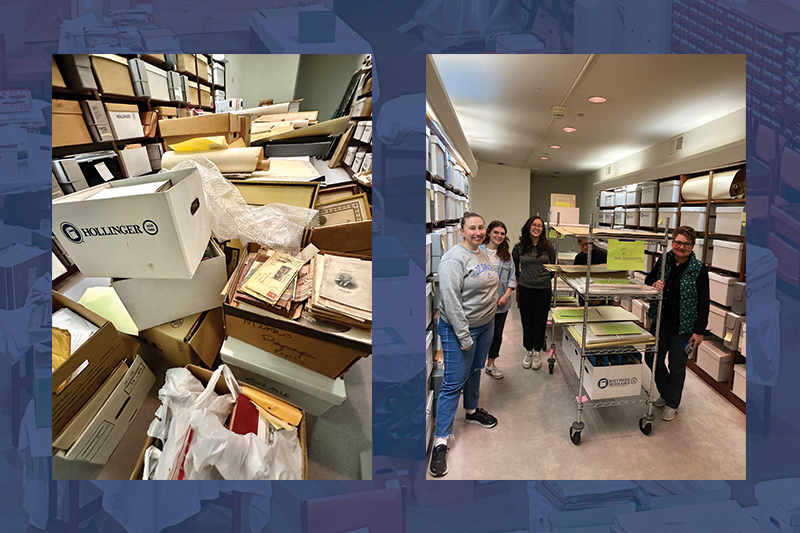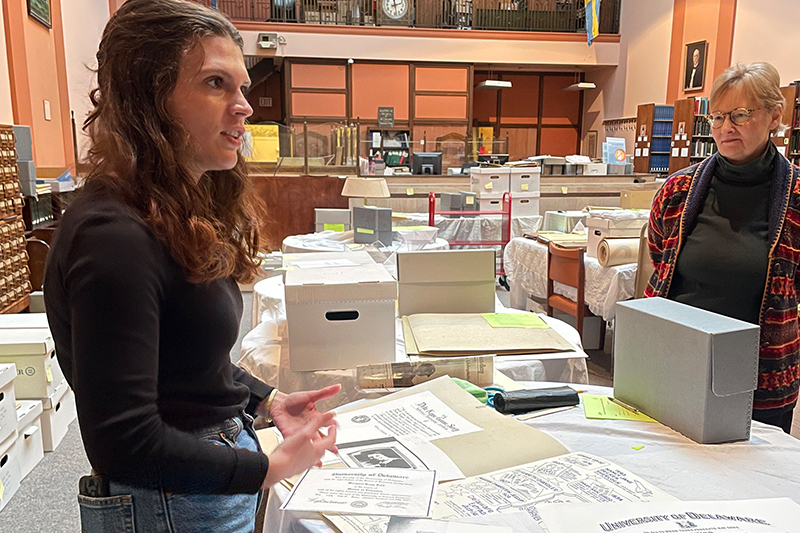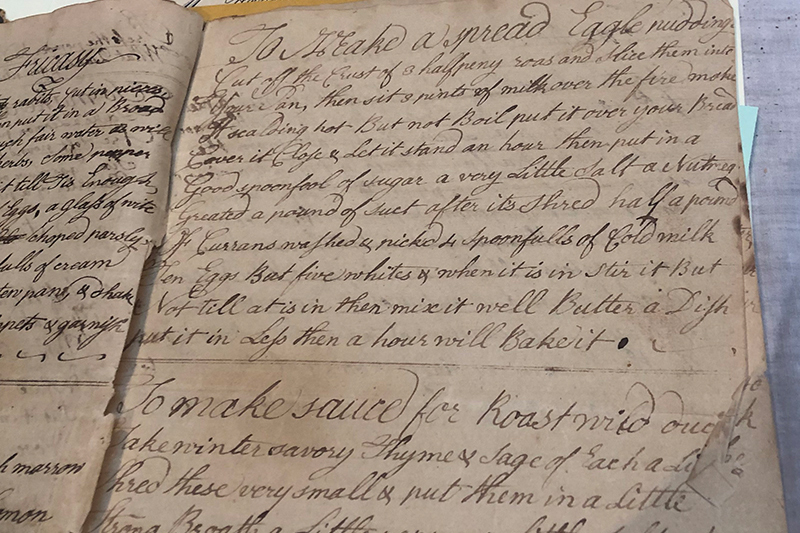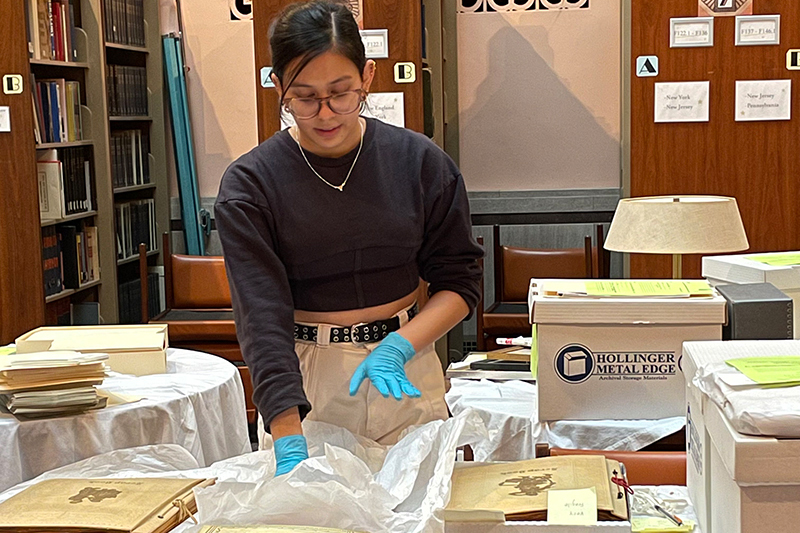


Untold stories of the First State
Photos courtesy of the Delaware Historical Society March 20, 2024
UD students uncover Delaware history through Museum Studies and Public Engagement’s community conservation project
At the Commencement ceremonies on Sunday, June 4, 1950, the mother-daughter duo of Margaret and Joan Ford received degrees from the University of Delaware. It was Margaret’s fourth degree from the University, beginning with a teaching certificate in 1929. When UD launched a four-year teaching degree a few years later, Margaret fought to be admitted to the program. She had since married and started her family, and according to Joan, the dean of women was reluctant to admit a married mother to the program. Margaret completed the bachelor of science in education, went on to earn two graduate degrees, and spent her career in Delaware public schools.
Margaret’s UD journey, and what it tells us about opportunities for married women 90 years ago, survives as more than just a family anecdote thanks to the UD’s Museum Studies and Public Engagement (MSPE) Program’s Collections AID (C-AID) service project.
Every January for the past decade, a group of UD museum studies students have participated in C-AID internships, helping local organizations organize, catalog and preserve their collections while gaining invaluable hands-on experience. This year, a group spent two weeks at the Delaware Historical Society (DHS) Research Library opening hundreds of boxes containing several thousand documents acquired over decades, including copies of Margaret Ford’s degrees, a newspaper clipping about the 1950 Commencement and a letter handwritten by Joan detailing her mother’s life.

The students, working with LuAnn De Cunzo, interim director of the Museum Studies Program, along with DHS staff members Leigh Rifenburg, chief curator, and Bill Robinson, preservation librarian, began by moving boxes from a large storage area into the main library room. Even this first step was carefully organized because no one had looked at the space in several decades, and museum staff didn’t know if there was already an organizational structure in place that would help with the project. The students recreated piles in case they found documents that needed to stay together.
No one knew what they might find.
“It was like the Wild West,” Rifenburg said. “We’ve learned along with the students. As they’ve been opening boxes, we’re as surprised as they are.”
Surprises also led to on-the-spot teaching moments.
“It's been really interesting figuring out on a case-by-case basis, what to do when, and ask questions,” said Samantha Hertel, first-year graduate student in the Department of History; the Hagley Program in the History of Capitalism, Technology, and Culture; and the MSPE certificate program.
What followed was essentially “collections triage” as students completed a form noting the item description, condition and donor information if available. They then placed the items in archival quality packaging. From there, museum staff will continue to process items, either adding them to the permanent collection or sending them to other organizations as appropriate.
“It’s an amazing learning experience for our students,” De Cunzo said. “We have students in history, art conservation, and this gives them a breadth of experience on top of their academic studies.
“There are a lot of different details you pick up on doing it with your hands versus talking about it in class,” said Emily Collopy, second year student in the Department of History and Hagley Program in the History of Capitalism, Technology and Culture. “I’ve had other internships before, and they were great experiences, but here I’m making decisions on my own and processing without somebody telling me what to do the entire time.”
Collopy calls food history one of her passions, so the most exciting moment for her was uncovering an unbound recipe book manuscript from 1765 that she found in a box of miscellaneous documents. The find is all the more interesting as the first American cookbook wasn’t published until about 30 years later, and few cooks of the time recorded many recipes at all, just those for special occasion dishes. The recipes are attributed to a woman named Margot Bolton, but it is unclear if she wrote the manuscript herself or it was copied by someone else.

“It’s a little delicate to look through it, but useful if you want to make a tansy pudding, or ragout of pig’s ear, or something called a spread eagle putting, it’s all here,” Collopy said.
During the triage stage, the team could not determine if the manuscript is specific to Delaware, which is another challenge the team faced. DHS has collected donations since it opened in 1864, and not everything people give fits in the society's collections scope. In this instance, other items found in the same box could be linked directly to cities in Delaware, so odds are good that Margot Bolton’s manuscript will remain with DHS.
Other times the Delaware connection is clear, like with a collection of scrapbooks belonging to Gloria Read, who married into one of Delaware historic families. Sophomore art conservation and anthropology major Akimah Kumar, who is minoring in museum studies, found the scrapbooks, and her background in conservation made her appreciate the objects themselves, as well as the stories.
“The most interesting thing about these scrapbooks is the different types of materials in here,” Kumar said.
Along with the expected photographs and newspaper clippings, Kumar found a piece of dog fur, a Russian dollar, bars of soap that Read saved from hotels, and several mementos from an old boyfriend named Ken, including a candy wrapper, a button from a pair of jeans and the laundry tag from one of his socks.
“These are slices of a person’s life,” Rifenburg said. “They are incredibly intimate to go through, and it’s fascinating that people make the decision to pass these on to be preserved by an institution like ours.”
Now that the C-AID project is completed, DHS can take the next step toward responsible stewardship of the collection.
C-AID is funded by a grant from the Delaware Humanities and the National Endowment for the Humanities, and from UOVO Fine Art Storage. Previous partnerships have included Howard High School of Technology, St. John AM Church, the Wilmington Metropolitan Urban league and the Christina Cultural Arts Center.

Contact Us
Have a UDaily story idea?
Contact us at ocm@udel.edu
Members of the press
Contact us at 302-831-NEWS or visit the Media Relations website

